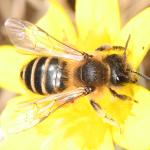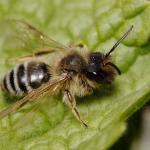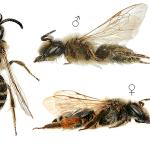Andrena fulvicrus (Kirby, 1802); Andrena contigua (Kirby, 1802); Andrena extricata Smith, 1849.
Widely distributed throughout southern England and the south coast of Wales. Most of the Welsh records are recent; Hallett apparently did not find it in places where it is now common (M Pavett, pers. comm.). Also recorded by Beavis (2000) on St Mary’s and Tresco (Isles of Scilly). Channel Islands.
Widespread and common in central and southern Europe, central Asia eastwards to India. North Africa.
This species is not regarded as being scarce or threatened.
May be found in a variety of open habitats with a slight preference for clay-based or sandy soils, although these need not be acidic. This species has undergone an expansion of range during the past decade or so.
Bivoltine; March to June, and July to September with some overlap, particularly of first generation females with second generation males.
May nest singly or in aggregations (sometimes very large) in patches of bare, or sparsely vegetated soil exposed to the sun.
Those of a wide range of plants, as long as the corollae are short.
2002




